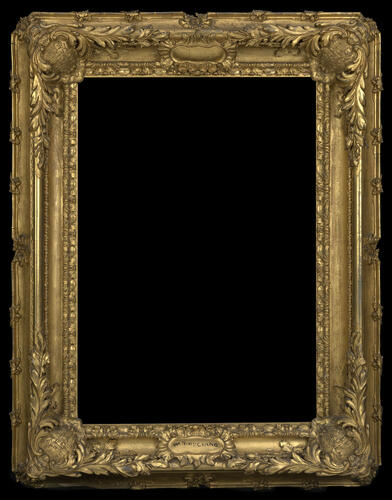-
1 of 253523 objects
Frame for RCIN 402876, Follower of Salviati, Giovanni della Casa 17th-century with 19th-century additions
Carved and water-gilded with oil-gilded composition additions | 88.4 x 69.0 x 11.0 cm (frame, external) | RCIN 7402876

British School, 18th century
Frame for RCIN 402876, Follower of Salviati, Giovanni della Casa 17th-century with 19th-century additions
-
This frame is an example of a carved Carlo Maratta frame with later additional ornament. The relatively modest Maratta frames were favoured in Roman picture galleries in the eighteenth century and were probably left on paintings as they were sold and entered foreign collections. The style was especially popular with British collectors and was copied for decades after. The name is derived from the Italian Baroque painter Carlo Maratta (1625-1713), whose works presumably first arrived in London in such frames.
The distinctive ‘Maratta’ ornament typically consists of a band of acanthus leaves and tongues or shields on the sight edge (nearest the picture surface) or in the front hollow (main curve of the frame); this can be enriched by pin-and-twisted-ribbon ornament, beading, or gadroons (teardrops). The profile of the frame is also easily recognisable - it has a deep front hollow and outward-curving top edge. In c. 1828 a group of paintings framed in eighteenth century British Carlo Maratta frames were extended to appear more imposing. The additions were made of moulded composition, or ‘compo’ (a pliable mixture of whiting, glue, resin and linseed oil which was first developed in London in the late eighteenth century). Many were remodelled in order to be incorporated into Jeffry Wyatville’s new decorative scheme for George IV in the Grand Corridor at Windsor Castle. This included twenty-two of the paintings by Canaletto acquired by George III from the Consul Smith collection. The carver and gilder Joseph Crouzet provided the most reasonable estimate, proposing to widen the frames to 4 ½ inches ‘by the addition of a new hollow moulding frame, mitred round the old frames with 2 new composition enrichments and 4 new composition corners.’ These extensions, including Rococo C-scroll foliate corners, made the frames grander enabling them to hold their own alongside the other larger frames in the Grand Corridor, such as the Morant frames surrounding paintings by Thomas Lawrence. The effect can be appreciated in Joseph Nash’s watercolour of the south end of the Corridor (1846, RCIN 919782).
Frames for other Italian paintings also received corner ornaments comprising a shield, bearing a coat of arms surrounded by oak leaves and an extended back rail; these appear to have been applied to frames of paintings recorded in the State Apartments at Windsor in c. 1835 (for example, del Sarto RCIN 7404427).
-
Creator(s)
(framemaker)(framemaker) -
Medium and techniques
Carved and water-gilded with oil-gilded composition additions
Measurements
88.4 x 69.0 x 11.0 cm (frame, external)
88.4 x 69.0 x 13.0 cm (frame, external, + buildup)
66.1 x 46.7 cm (frame, rebate)
63.0 x 43.5 cm (sight)
12.5 cm (Width) (frame, section)
Category
Object type(s)